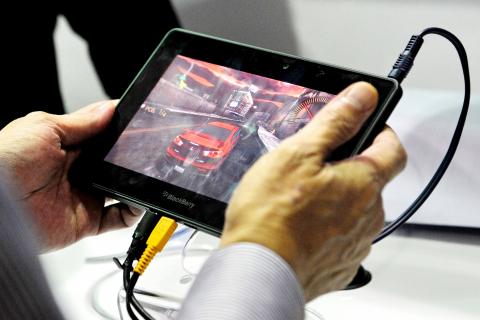More virtual livestock looks set to be traded and petulant fowl hurled at targets as social gaming takes hold in the booming mobile phone market, industry experts say.
Social gaming, made popular by titles such as Farmville and Angry Birds, was one of the closely followed topics at last week’s CommunicAsia trade fair in Singapore, where telecom executives meet annually to check on new trends.
Internet-enabled smartphones as well as tablets are liberating social gamers from the physical confines of home and office and more titles specifically designed for handheld devices are on their way.

Photo: AFP
Asia-Pacific smartphone sales are expected to reach 200 million a year by 2016, a third of all mobile phones sold in the region, according to telecom consultancy Ovum.
“At least 90 percent of gamers will be mobile in the future,” said Jeffrey Jiang, a director at Singapore-based Touch Dimensions, which develops games for various platforms.
He said his firm’s clients now favor social games designed for mobile phones rather than personal computers or consoles such as the Xbox 360.
“When I started in the industry, all the projects were mostly PC, hardly any mobile, but now most of the projects that people ask from us are about mobile,” he said.
Jiang, whose firm creates games for mobile brands such as the iPhone, Android and Nokia, said light social gamers rather than hardcore videogame players would be the drivers of developer industry growth.
“The majority of the population are going to be casual gamers and casual gamers are not really that willing to play their games just on the PC ... Everyone has mobile devices so it’s the logical shift.”
Farmville, which enables players and their friends to turn themselves into rural folk plowing fields and trading pigs and cows, is the most popular game on Facebook and has made its developer Zynga a fortune.
With Zynga preparing to offer its shares soon, The Wall Street Journal has quoted sources as saying the developer could be valued at US$7 billion to US$9 billion after making US$400 million in profit on approximately US$850 million in revenue last year.
More than 250 million people a month play Zynga games which also include CityVille, FrontierVille, Cafi World, YoVille, and Vampire Wars, according to the developer.
In Angry Birds, developed by Finnish company Rovio, players catapult birds at enemy pigs which have stolen their eggs — players post their scores and discuss the game on social media sites.
Social game developers make money by selling their games as paid applications on mobile platforms such as Apple’s AppStore, with various upgrades available as users become more addicted.
Zynga senior vice president David Ko said about 1.1 billion smartphones — mobile devices with features such as video cameras and Internet capability — are expected to be shipped worldwide in 2015, double this year’s forecast.
This creates a “tremendous opportunity” to reach more players, he said.
Ko said gamers have pressed Zynga to devote more resources to mobile platforms, “so an important part of our strategy is making sure that we have mobile extensions of all of our IPs [intellectual properties] going forward.”
Nokia, the world’s leading mobile phone maker, said gamers were the biggest customers of its applications store Ovi.
At Apple’s AppStore, mobile games are the best-selling items, filling nine out of the top 10 slots.
Even BlackBerry, a brand more synonymous with businessmen rather than the gaming fraternity, showcased the gaming capabilities of its first tablet model, the Playbook at CommunicAsia.
It set up four flatscreen televisions connected to Playbooks enabling players to compete in the racing game Need for Speed.
Thomas Crampton, a Hong Kong-based media consultant, said the rise of the smartphone made social gaming viable.
“The connectiveness to the Internet is important because it gives you that social link and the social aspect of gaming is really going to be a huge driving factor,” said Crampton, Asia-Pacific director of Ogilvy Public Relations’ global social media team.

Nissan Motor Co has agreed to sell its global headquarters in Yokohama for ¥97 billion (US$630 million) to a group sponsored by Taiwanese autoparts maker Minth Group (敏實集團), as the struggling automaker seeks to shore up its financial position. The acquisition is led by a special purchase company managed by KJR Management Ltd, a Japanese real-estate unit of private equity giant KKR & Co, people familiar with the matter said. KJR said it would act as asset manager together with Mizuho Real Estate Management Co. Nissan is undergoing a broad cost-cutting campaign by eliminating jobs and shuttering plants as it grapples

TEMPORARY TRUCE: China has made concessions to ease rare earth trade controls, among others, while Washington holds fire on a 100% tariff on all Chinese goods China is effectively suspending implementation of additional export controls on rare earth metals and terminating investigations targeting US companies in the semiconductor supply chain, the White House announced. The White House on Saturday issued a fact sheet outlining some details of the trade pact agreed to earlier in the week by US President Donald Trump and Chinese President Xi Jinping (習近平) that aimed to ease tensions between the world’s two largest economies. Under the deal, China is to issue general licenses valid for exports of rare earths, gallium, germanium, antimony and graphite “for the benefit of US end users and their suppliers

Dutch chipmaker Nexperia BV’s China unit yesterday said that it had established sufficient inventories of finished goods and works-in-progress, and that its supply chain remained secure and stable after its parent halted wafer supplies. The Dutch company suspended supplies of wafers to its Chinese assembly plant a week ago, calling it “a direct consequence of the local management’s recent failure to comply with the agreed contractual payment terms,” Reuters reported on Friday last week. Its China unit called Nexperia’s suspension “unilateral” and “extremely irresponsible,” adding that the Dutch parent’s claim about contractual payment was “misleading and highly deceptive,” according to a statement

The Chinese government has issued guidance requiring new data center projects that have received any state funds to only use domestically made artificial intelligence (AI) chips, two sources familiar with the matter told Reuters. In recent weeks, Chinese regulatory authorities have ordered such data centers that are less than 30 percent complete to remove all installed foreign chips, or cancel plans to purchase them, while projects in a more advanced stage would be decided on a case-by-case basis, the sources said. The move could represent one of China’s most aggressive steps yet to eliminate foreign technology from its critical infrastructure amid a